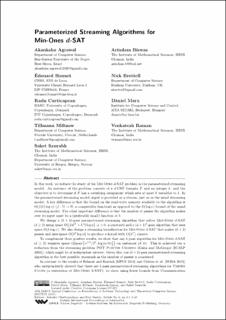| dc.description.abstract | In this work, we initiate the study of the Min-Ones d-SAT problem in the parameterized streaming model. An instance of the problem consists of a d-CNF formula F and an integer k, and the objective is to determine if F has a satisfying assignment which sets at most k variables to 1. In the parameterized streaming model, input is provided as a stream, just as in the usual streaming model. A key difference is that the bound on the read-write memory available to the algorithm is O(f(k) log n) (f: N -> N, a computable function) as opposed to the O(log n) bound of the usual streaming model. The other important difference is that the number of passes the algorithm makes over its input must be a (preferably small) function of k. We design a (k + 1)-pass parameterized streaming algorithm that solves Min-Ones d-SAT (d >= 2) using space O((kd^(ck) + k^d)log n) (c > 0, a constant) and a (d + 1)^k-pass algorithm that uses space O(k log n). We also design a streaming kernelization for Min-Ones 2-SAT that makes (k + 2) passes and uses space O(k^6 log n) to produce a kernel with O(k^6) clauses. To complement these positive results, we show that any k-pass algorithm for or Min-Ones d-SAT (d >= 2) requires space Omega(max{n^(1/k) / 2^k, log(n / k)}) on instances (F, k). This is achieved via a reduction from the streaming problem POT Pointer Chasing (Guha and McGregor [ICALP 2008]), which might be of independent interest. Given this, our (k + 1)-pass parameterized streaming algorithm is the best possible, inasmuch as the number of passes is concerned. In contrast to the results of Fafianie and Kratsch [MFCS 2014] and Chitnis et al. [SODA 2015], who independently showed that there are 1-pass parameterized streaming algorithms for Vertex Cover (a restriction of Min-Ones 2-SAT), we show using lower bounds from Communication Complexity that for any d >= 1, a 1-pass streaming algorithm for Min-Ones d-SAT requires space Omega(n). This excludes the possibility of a 1-pass parameterized streaming algorithm for the problem. Additionally, we show that any p-pass algorithm for the problem requires space Omega(n/p). | en_US |

